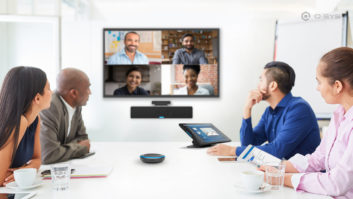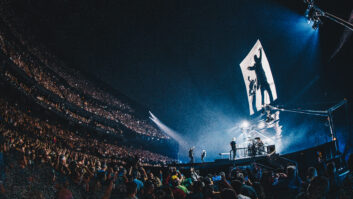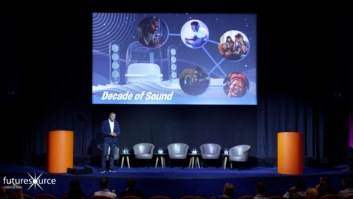With so many headline-making developments in video technology over the past 10 years, it has occasionally felt as if audio has been overshadowed in the broader industry debate. But judging by the numerous significant developments explored during Futuresource Consulting’s latest Audio Collaborative event – which took place in Central London on 9 November – that is unlikely to be the case for much longer.
Personalisation, sustainability and, inevitably, AI were among the topics explored during a busy day-long programme in keeping with Futuresource director of research Carl Hibbert’s assertion that “the agenda is a zeitgeist of the contemporary audio industry”. There isn’t space here to document all of the proceedings, so instead Installation has alighted upon a trio of sessions that seemed especially revelatory.
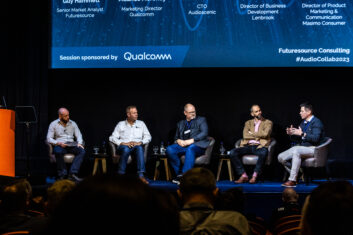
In ‘Overcoming the Innovation Roadblock’, moderator Johnny McClintock (Audio Codecs) and panellists Elfed Howells (Elevear), Tim Degraye (HED Unity) and Mehul Kochar (Knowles) examined the implications of the eponymous term, which posits that consumers are happy with current technologies, so what are going to be the next ‘must-haves’ and how should brands respond in terms of new R&D…?
Taking issue with the title, Howells said he “doesn’t recognise this ‘innovation roadblock”; I think it is probably the most interesting time to be in this business.” Explaining his reasoning, he cited developments include continual improvement to algorithms and chips, as well as research – including from Audio Collaborative diamond sponsor Qualcomm – that consistently shows “people want better audio”.
Several panellists alluded to the potential for improved listening experiences, not least through the use of Bluetooth and/or WiFi to stream very high quality, lossless audio. The importance of looking after your hearing in an excessively noisy era was another recurring theme.
“A lot of people want to experience lossless audio. [Simultaneously] I think there is a tremendous opportunity to re-educate the world about the importance of audio health,” said Degraye, who like the other panellists was generally upbeat about the future of audio: “There is so much innovation [happening] and so many opportunities that everyone wins.”
Howells highlighted what he terms the “three Ss… silicon, software and sensors.” Accelerating innovation in chip design is giving audio developers “a huge amount of firepower”, whilst an evolving software ecosystem is providing vendors and consumers with more and more options. Meanwhile, sensor innovation will allow devices to respond to the behaviour of the consumer as well as “monitoring health and so on… [With the three Ss in combination] I think there is a lot of real innovation coming.”
Meanwhile, Kochar introduced a theme that was to permeate the entire day. “Audio personalisation is coming in various forms, starting with how the ear is, the shape of it, and how people hear differently,” he said, adding that he also expected more developments allowing adjustments to audio depending on levels of background noise.
PERSONALISATION PRINCIPLE
The “democratisation of audio” through more bespoke audio was also the subject of a separate session entitled ‘Servicing the Consumer Through Personalisation’. Chaired by Futuresource principal analyst Rasika D’Souza, the session featured panellists Rupert Brun (consultant for Fraunhofer working on MPEG-H Next Generation Audio), Jacob Hooker (Analog Devices) and Helmut Berns (Sonarworks).
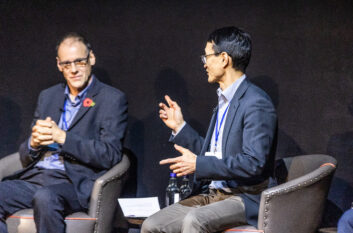
Hooker observed that “personalisation covers a really wide spectrum of things”, including the development of user interfaces that are appealing and can accommodate the increasing scope and range of content. “I think we will see a massive amount of development in interfacing and how people interact with the product,” he said.
For Brun, “audio objects will be key in the drive to personalisation. Ever since the dawn of media we have mixed content down and sent it to the consumer – as mono, stereo then immersive – as a fully mixed thing. With audio objects you don’t have to do that; [instead] as the content creator you can keep some [aspects of] content separate and send it to the device along with instructions about what to do with them and where they should be in the soundstage.” Moreover, it will be possible for mixes to adjust to the listening environment, be it “an immersive audio set-up at home or on the bus where it’s noisier and [for example] have the dialogue louder and the background sound turned down.”
AI is also likely to have a transformative effect on personalisation. “Not only will you be able to change the volume of the voice, you will also be able to change the voice altogether,” said Berns, referencing an application in which the voice of the sports commentator could be changed out in line with the listener’s preferences.
HEARING HEALTH
Picking up again on the theme of hearing health, Brun drew attention to some societal developments that will inevitably help to shape future personalisation.”We have an ageing population and it has been calculated [by the RNID] that there are 12 million people in the UK with some form of hearing loss,” he said. “It’s more predominant among older people where you get presbycusis, which makes it harder to understand [conversation in a noisy environment]; it gets us all eventually, to a greater or lesser extent.” Factor in the numerous public and private spaces in which people now consume media, and it’s clear that “one sound balance does not work for everybody”.
For consumers to fully engage with personalisation, though, “it needs to be an easy, fun experience,” said Hooker. “Knowing how to change things with the lowest effort [is very important]. It needs to be an easy to use interface and a fun experience [that doesn’t involve] having to worry about what is going on under the bonnet.”
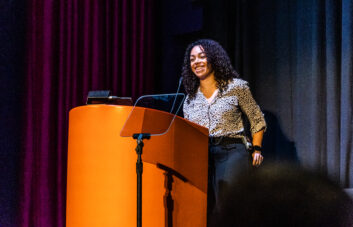
The session concluded with a deeper-dive into the phenomenal evolution of AI. “It’s happening so fast that it’s hard to keep track of what is happening,” said Berns. “One AI development researcher I talk to monitors all the publications coming out, and he says that physically it is impossible to read everything. If you select the best papers to read now, by the time you finish them the next [few hundred documents] will have already come out!”
The combination of AI and personalisation is undoubtedly powerful, but raises complex questions around the integrity of artistic output – for example, music or film – and the extent to which content should be manipulated by the consumer. Opinions varied on this one, although it was hard to argue with Brun’s assertion that it’s “not just a legal [matter], but also a philosophical one as to where the line is. It’s totally personal and will be different [for different people].”
HOORAY FOR HI-RES
The onward march towards higher quality audio was addressed in a session featuring Maurice Moroney, marketing director of Qualcomm, and Futuresource’s Carl Hibbert. “We have run our own surveys and got the same feedback over several years, [which is that] year-on-year the number of people requesting high-resolution is going up, so it’s definitely a big issue for a lot of people,” said Moroney.
Qualcomm’s integrated WiFi and Bluetooth mobile connectivity systems are supportive of “the highest bandwidth and highest-resolution audio, ie. 24-bit/96kHz.” The blending of these technologies, indicated Moroney, will support a seamless audio experience wherever the user is situated. In combination with personalisation, scenarios like the following one become increasingly feasible: “Imagine you walk into an airport and want to know which gate your plane is taking off from. Every gate has its own transmitter and so you can get only the details you need – you don’t have to listen to all the other information [about other flights, etc].”
With regard to AI, Moroney highlights the importance of keeping latency low when backup to the cloud is involved. He envisages that AI will yield further improvements to ANC (Active Noise Cancellation) and “provide better voice calling performance [through the] elimination of background noise.”
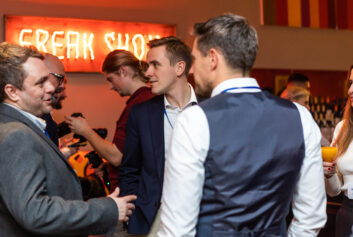
The conference also saw some breaking news from title sponsor HARMAN, which announced that it had acquired FLUX Software Engineering, known for its innovation in immersive audio production, audio processing plug-in design and audio analysis. The deal is set to broaden HARMAN Professional’s offerings across multiple applications with “world-class immersive technology”.
Reflecting on the 10th edition of Futuresource’s flagship event, Hibbert remarked: “Audio Collaborative 2023 was a hugely successful day, and HARMAN delivering such important news to our attendees is a testament to that. Each year, we put on a range of topical panels on the biggest trends gripping the audio sector. As well as providing valuable insights, we aim to give guests the opportunity to network with other industry participants. This year, we were bowled over by the quality of conversations permeating the event. 2023 represented the 10th anniversary of Audio Collaborative, so we’re delighted to confirm it lived up to our expectations.”
For details of Futuresource’s upcoming events – including Pro AV Collaborative 2024 and Edtech Collaborative 2024, both taking place in January – please visit https://www.futuresource-consulting.com/events-conferences/.
